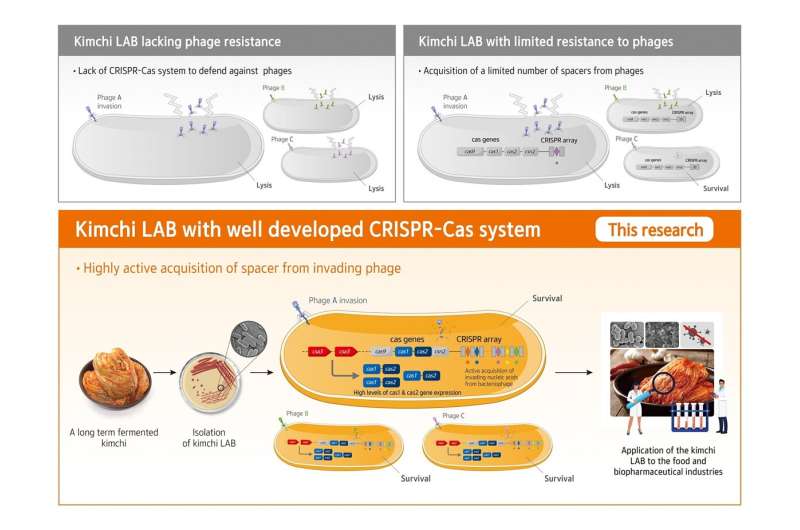This article has been reviewed according to Science X's editorial process and policies. Editors have highlighted the following attributes while ensuring the content's credibility:
fact-checked
trusted source
proofread
Research team discovers lactic acid bacteria strains with high virus resistance from kimchi

From kimchi fermented at low temperatures for a long period of time, researchers at the World Institute of Kimchi have isolated lactic acid bacteria (LAB) strains with high levels of resistance to phages. They have also identified the defense mechanism of the LAB strains against phages, viruses that infect and replicate within bacteria.
Kimchi, a traditional Korean food, is a lactic acid-fermented vegetable product. Unlike fermented dairy products, which are produced under a sterilized-closed fermentation system, kimchi is produced through spontaneous fermentation initiated by various microorganisms present in the raw materials under a non-sterilized-open fermentation system. Thus, various LAB can be involved in kimchi fermentation, and the diversity of the dominant LAB and the periods during which they are dominant differ depending on the environment.
To identify the genetic traits of kimchi LAB in long-term fermented kimchi stored at low temperature, researchers at the World Institute of Kimchi collected 34 samples of kimchi fermented for more than 6 months at low temperatures of -2 to 10℃ from all over South Korea. In more than 88% of the collected kimchi samples, a specific LAB strain, Pediococcus inopinatus, was found to be the dominant species.
Their work is published in the journal Food Microbiology.
Through whole-genome sequencing analysis, the researchers found that P. inopinatus has a very well-developed clustered regularly interspaced short palindromic repeat (CRISPR). CRISPR is a prokaryotic adaptive immune system composed of a combination of several genes depending on the LAB strain.
Specifically, the P. inopinatus strains possess more copies of the csa3 gene—the gene coding for the transcription factors for the cas genes—than other LAB strains. Also, due to the active expression of cas genes, P. inopinatus strains store much more genetic information about phages.
Therefore, after the first phage infection, P. inopinatus will be more effective in preventing subsequent infection with similar phages. The kimchi industry has been using kimchi LAB as a starter for the production of standardized kimchi with better sensory qualities. Just as humanity is threatened by the COVID-19 virus, these starters are also at risk of infection from phages.
Therefore, the development of phage-resistant LAB strains is necessary. Additionally, among the kimchi LAB reported in this study, one LAB strain had a gene sequence that could play an immune role not only against phages but also against mammalian viruses.
Dr. Hae Choon Chang, President of the World Institute of Kimchi and the corresponding author of this study, said, "P. inopinatus possesses a unique, well-developed CRISPR system that can defend against a variety of viral invasions." She also stated, "We are planning to study the antiviral activity and analyzing the immune spectrum of P. inopinatus, and we expect that the excellent antiviral ability of these kimchi LAB strains can be used not only in food but also in the pharmaceutical industry."
More information: So Yeong Mun et al, Pediococcus inopinatus with a well-developed CRISPR-Cas system dominates in long-term fermented kimchi, Mukeunji, Food Microbiology (2023). DOI: 10.1016/j.fm.2023.104385
Provided by Korea Institute of Science and Technology





















